|
|
|
February 5th, 2013, 22:37 Posted By: wraggster
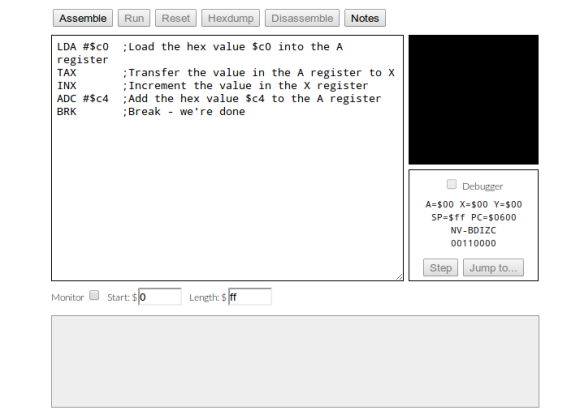
Evern wanted to write your own Atari 2600 games? This won’t get you quite that far, but it will teach you the very basics. It’s an assembly tutorial for the 6502 processor. The nice thing is that you need nothing more than your browser to participate thanks to the embedded JavaScript emulator which acts as assembler, machine, and debugger in one.
The 6502 was in a lot of early equipment. In addition to the previously mentioned Atari they can be found in the Commodore 64, Apple II, and the original NES. You can even find folks building their own computers around the chip these days (most notable to us is the Veronica project). The guide starts off slowly, providing a working program and challenging the reader to play with to code in order to alter the outcomes. It moves on to an overview of registers and instructions, operators and branching, and culminates in the creation of a simple game.
http://hackaday.com/2013/02/05/learn...502-processor/
To read more of the post and Download, click here!
 Join In and Discuss Here Join In and Discuss Here
Submit News and Releases Here and Contact Us for Reviews and Advertising Here |
|
 |
|
|
|
February 5th, 2013, 22:38 Posted By: wraggster
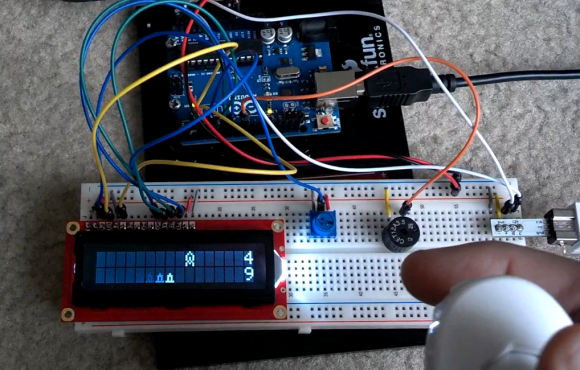
This Space Invaders game does more with less. [Rjk79] managed to make a video game using a two-line character display. The game consists of a wave of invaders on the top line, with the defender cannon on the bottom. The invader isn’t just stationary, but randomly moves to the left and the right. The image above captured a little bit of motion blur from the defender moving into position before firing on the enemy.
An Arduino board controls the 16×2 HD44780 character display. The game also includes sounds generated by the piezo buzzer seen on the breadboard. All the way to the right you can see the Wii Nunchuk breakout board which provides directional control and the firing trigger. If you want to recreate this one for yourself [Rjk79] is sharing the source code on Pastebin. There’s also a demo video found after the jump.
If you don’t have a character LCD on hand you might try this other Space Invaders clone that uses an 8×8 led matrix.
http://hackaday.com/2013/02/04/space...acter-display/
To read more of the post and Download, click here!
 Join In and Discuss Here Join In and Discuss Here
Submit News and Releases Here and Contact Us for Reviews and Advertising Here |
|
 |
|
|
|
February 8th, 2013, 22:54 Posted By: wraggster
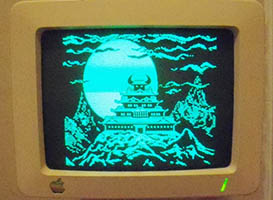
One of the most commonly frustrating things about having an old Apple ][ lying around in your basement or attic is the lack of software. While at one time in the late 80s you may have had your own copy of Oregon Trail, that disk is either lost or non-functional, and it's pretty hard to get new disk images onto 5 1/4" disks.
To solve this problem for himself, [Eric] came up with an Apple disk emulator. A project like this has been done many, many times over the last few decades, but [Eric] put his own twist on it: he doesn’t use a microcontroller. Instead, he used a simple USB FTDI device to talk to the Apple disk drive.
The FTDI device in question is a UM232H chip that takes a USB connection and turns it into an SPI bus. Of course the Apple ][ disk doesn't speak SPI, so [Eric] needed to do a little logic conversion with a 74LS251 multiplexer and a 74LS161 counter.
In the video after the break, you can see [Eric] loading Apple disk images on a IIc from his new Intel Mac. It’s a neat build, but it’s not done yet: [Eric] plans on adding a microcontroller with an SD card, allowing just about every Apple ][ game every made to fit in your pocket. Yes, [Eric]‘s project is quite similar to the A][ pocket serial host we saw just a bit ago, but this will hopefully have a lower component count.
http://hackaday.com/2013/02/07/usb-apple-disk-emulator/
To read more of the post and Download, click here!
 Join In and Discuss Here Join In and Discuss Here
Submit News and Releases Here and Contact Us for Reviews and Advertising Here |
|
 |
|
|
|
February 11th, 2013, 21:37 Posted By: wraggster
 It is rare indeed for a single game to become the progenitor of an entire new genre. Although it had its precedents, with some fans attempting to retcon a gaggle of faintly similar 8bit titles for the role, the world’s first realtime strategy game can be named with little real controversy.But going back to Dune II today is an eye-opening experience, as it becomes clear how very little the genre has moved forwards – like finding out Halo had really been released in 1982. The same basic viewpoint, interface, controls and gameplay underpinning Dune II are still being reused today, with only the most minimal level of evolutionary advancement.Lacking any of the hexes or grid squares of contemporary turn-based strategies, Dune II was loosely based upon the David Lynch movie, at least in terms of visual design. The gameplay featured three different factions (one invented for the game) all with individual structures, units and superweapons. It is rare indeed for a single game to become the progenitor of an entire new genre. Although it had its precedents, with some fans attempting to retcon a gaggle of faintly similar 8bit titles for the role, the world’s first realtime strategy game can be named with little real controversy.But going back to Dune II today is an eye-opening experience, as it becomes clear how very little the genre has moved forwards – like finding out Halo had really been released in 1982. The same basic viewpoint, interface, controls and gameplay underpinning Dune II are still being reused today, with only the most minimal level of evolutionary advancement.Lacking any of the hexes or grid squares of contemporary turn-based strategies, Dune II was loosely based upon the David Lynch movie, at least in terms of visual design. The gameplay featured three different factions (one invented for the game) all with individual structures, units and superweapons.
Although it is hard to appreciate now, being able to control each directly with the mouse – simply by pointing and clicking wherever you want them to move to or attack – was revolutionary. As was the need to harvest spice to act as the resource that feeds the expansion of your army.“The inspiration for Dune II was partly from Populous, partly from my work on Eye Of The Beholder and the final and perhaps most crucial part came from an argument I once had with Chuck Kroegel, then vice president of Strategic Simulations Inc,†recalls Westwood Studios co-founder and Dune II producer Brett Sperry.“The crux of my argument with Chuck was that wargames sucked because of a lack of innovation and poor design. Chuck felt the category was in a long, slow decline, because the players were moving to more exciting genres,†he explains.“I felt that the genre had a lot of potential – the surface was barely scratched as far as I as concerned, especially from a design standpoint. So I took it as a personal challenge and figured how to harness realtime dynamics with great game controls into a fast-paced wargame.â€Technosoft’s 1990 Mega Drive game Herzog Zwei is often labelled as a primary inspiration for Dune II, but according to Sperry greater influence came from a more mundane source. “Herzog Zwei was a lot of fun, but I have to say the other inspiration for Dune II was the Mac software interface. The whole design/interface dynamics of mouse clicking and selecting desktop items got me thinking, ‘Why not allow the same inside the game environment? Why not a context-sensitive playfield? To hell with all these hot keys, to hell with keyboard as the primary means of manipulating the game!’â€The influence of MacOS (at the time the text interface of MS-DOS still held equal ground with Windows on PCs) on Sperry is perhaps unsurprising given his initial game industry experience as an Apple II programmer. “I started programming in high school when I was 16 years old and initially I did ports to the Apple II, some utilities and six ‘edu-games’. My first big game was called Terra 12 but it was never published. Around 1984 I met Louis Castle during a port of Impossible Mission for the Apple II that I was working on. Louis did most of the art and animation on that project. In fact, after seeing his superior artwork, that was the end of my computer art career!â€â€œLouis and I started Westwood Studios in March of 1985 as a 16bit game company. Our early games were for the Amiga and the Atari ST. We were a three-man shop initially [with programmer Barry Green]. Louis did all the artwork, all three of us were programming, and each of us did some of the audio work.â€Sperry stopped programming in 1987, though, as the demands of design work, running the new company and overseeing production on all of Westwood’s games was all becoming too much. “With the rise of the 16bit machines, the rules and standards changed dramatically. We actually had to hire two artists and an audio guy. Almost overnight the industry went from one and two-man teams, to groups of five or six.â€Apart from proving that some things in the game industry never change, Sperry also recalls that by the same period he was getting bored with programming: “For me, game conceptualisation and design was the hardest and the most exciting job of all, and I was jealous of any time I spent away from doing that.â€Conceptualisation of Dune II itself began with an approach from Martin Alper, president of Virgin Games. “Martin asked what I thought about Frank Herbert’s Dune books and the Dune movie,†remembers Sperry. “I loved the books and I loved David Lynch’s movie as well, and I told him as much. Martin told me he had locked up the licence years ago and I could use it if I wished.â€Alper’s comments to Sperry had been made with the understanding that work by French developer Cryo on a Dune-themed adventure/strategy hybrid had already been cancelled. As Sperry later found out, however, Cryo hadn’t taken no for an answer. “They rushed to finish their game before ours,†he reveals. “The result was a branding nightmare – the Cryo game had nothing to do with ours and yet it was published first because Virgin was anxious for the revenue. Against my violent protests our game was called Dune II: The Building Of A Dynasty [Battle For Arrakis in Europe and for the Mega Drive version] and the rest is history.â€Initial development was hardly any less problematic, as Sperry recounts: “Joe Bostic was my lead programmer, and I remember telling him about how I wanted the units to move around on the battlefield and the basics of combat. And so he put it all together, and the resultant game was really boring!â€At this stage, though, the game bore little resemblance to the final product, with only four to eight units fighting on each side. “When we played with it, the whole game was over in no time. So we worked in obstacles on the battlefield and later production dynamics, the base and unit construction, and the fog of war effect. The production dynamics were partly inspired by Civilization. Sid [Meier]’s production dynamics gave me ideas on how to make Dune II more interesting.â€According to Sperry there was no fleshed-out game design and development was largely organic. “I wasn’t very good at communicating what I saw in my mind,†he admits. “I knew how I wanted the controls and interface to work very clearly, but some of the unit dynamics and pacing were still murky. So we basically built the game iteratively and the design documents were often made up as we went along.â€This open-ended approach to game design is clearly how Sperry prefers to work, admitting that today he spends more time as a voyeur than a player. “When I focus on watching others play, I learn more about game design and entertainment, what’s working, what’s frustrating and how much or little players are willing to put up with and why. Game design and gamer interaction is still a source of endless fascination for me.â€Sperry describes Dune II’s core challenge as “combining combat, exploration and production at a particular pace and rhythm to make it all exciting and almost out of control. That was a key part of what made it so addictive.†Indeed, the experience was quite unlike more staid turnbased strategies, where success or failure rolled in slowly rather than rushing over sand dunes at the speed of an action game.“You had to think and respond fairly quickly, and in realtime, or else your base and forces would all be overrun. And as we developed the game further, it became clearer how the pacing and battle scenario design were all a delicate balance.â€In spite of concern over the obscure title the game was an immediate hit when released in 1992. “We called Dune II a ‘realtime strategy’ game – we did that to make it clear to software retailers and users that we had something new,†says Sperry, who seems to have been afforded the rare chance to not only create a new genre but to name it as well. “But it was a wargame at heart. You built and managed units and took out the other side. Once people tried the game, they were hooked, and soon Dune II was a huge commercial success.â€As work on the game came to a close, Sperry was working on its successor: “I was evolving my designs and figuring out how to streamline the interface even more. I had developed a new game and mythos with a modern-day setting, and that’s how Command & Conquer was born.â€Although Dune II earned itself two sequels – a remake in 1998 named Dune 2000 and the more favourably received sequel Emperor: Battle For Dune in 2001 – it is the Command & Conquer series that is the game’s true legacy. The series is still the most successful realtime strategy franchise today and its debt to Westwood’s original games is immediately obvious.Sperry has little to offer in support of subsequent entries in the genre, though. “The few wargames I’ve played lately have left me uninspired,†he admits. “I don’t really recognise the realtime strategy genre as such on consoles.â€â€œThat said, gaming today is still fun and exciting to me personally. I play World Of Warcraft with some friends on a PvP server. I thoroughly enjoyed BioShock and I still play Mario Kart from time to time. Mostly social games and multiplayer games are what appeal to me. The quality of games is still a mixed bag despite all the new technology. But hasn’t it always been like this? In music, literature and film we see the same thing – lots on offer, but a pretty small number of exciting gems each year. And I can assure you that, like other entertainments, every game project starts out as something new and exciting in its creator’s minds. But without a great design, critical feedback and a solid team, it’s still a dicey outcome.â€
http://www.edge-online.com/features/...ng-of-dune-ii/
To read more of the post and Download, click here!
 Join In and Discuss Here Join In and Discuss Here
Submit News and Releases Here and Contact Us for Reviews and Advertising Here |
|
 |
|
|
|
February 11th, 2013, 21:39 Posted By: wraggster
PC giant Nvidia is on the hunt for a supplier to release its new games console into the UK.
The firm, best known for its graphics cards, revealed Project Shield at the Consumer Electronics Show in Las Vegas last month. The portable plays Android titles and can even stream games from the PC.
Developers are already on-board with games optimised for Shield, including Bohemia Interactive, which has made an Arma title for the product.
But although the console is due to launch in the US and Canada in Q2, it has yet to secure a UK supplier and is open to offers.
“We want to sprint to get it into the key markets in Europe and Asia,†said Nvidia’s director of product marketing Jason Paul.
“Since the announcement we’ve had people knocking on our door. So there’s interest in distributing the product. Shield is targeting Android and PC gamers, so we are looking for people who can sell into that market.â€
Nvidia developed the graphics chip in PS3, but is now taking its own steps into hardware development. And Paul was delighted by the press response.
“We thought that Project Shield would raise the bar for Android and PC gaming,†he added. “When we looked at the complexity of the device, with all the streaming tech, we came to the conclusion that we had a device that only we could build ourselves. It is a natural step for us.
“The response has been overwhelming. We won over 30 best of show awards at CES. The amount of new coverage we received was more than anything we have ever had before.â€
http://www.mcvuk.com/news/read/uk-di...onsole/0110702
To read more of the post and Download, click here!
 Join In and Discuss Here Join In and Discuss Here
Submit News and Releases Here and Contact Us for Reviews and Advertising Here |
|
 |
|
|
|
February 14th, 2013, 15:25 Posted By: wraggster
via http://www.romhacking.net/
Biomotor Unitron 2 - SKikouseki Unitron was released in Japan in 2000. After SNK’s bankruptcy the title failed to reach its way over stateside. With a little luck we’ll have a complete package ready for your enjoyment within the coming months. The game gives you everything you wished the 1st Unitron title did. For example, choosing a specific partner gives you a completely different Unitron to use, instead of being stuck with just one and modifying it from there.
I will be going slight graphical overhauls of the intro and the attributes or affinities (per Biomotor 1), to display as fire, ground, tree, water, light, darkness etc.
Except a lot of awesomeness coming down the line very soon from Wynd productions. Ha!
http://www.romhacking.net/translations/1793/
To read more of the post and Download, click here!
 Join In and Discuss Here Join In and Discuss Here
Submit News and Releases Here and Contact Us for Reviews and Advertising Here |
|
 |
|
|
|
February 15th, 2013, 14:49 Posted By: wraggster
To read more of the post and Download, click here!
 Join In and Discuss Here Join In and Discuss Here
Submit News and Releases Here and Contact Us for Reviews and Advertising Here |
|
 |
|
|
|
February 17th, 2013, 23:49 Posted By: wraggster
via http://zx81.zx81.free.fr/serendipity...Cartridge.html
Hi all,
With my good friend Buzz, we spent last past few weeks on a new project called "63 in 1".
This is a home made cartridge with 63 games, an enhancement of our previous "31in1" colecovision cartridge.
 
All the hardware part is well described on buzz web site, with schematcs and eagle files : here
The loader is a modified version of the 31in1. All the source code is provided under BSD like license here :
63in1.zip
It contains also the eprom file i've used for this demo :

Finally this archive contains all files needed to build your own cartdridge (eagle files for the PCB etc ...)
If you are interested in making your own cartridge here is a model you can print :here

For people like me, who don't have the solder skill of Buzz, you may give a try to a 'test board' version, as i did here :
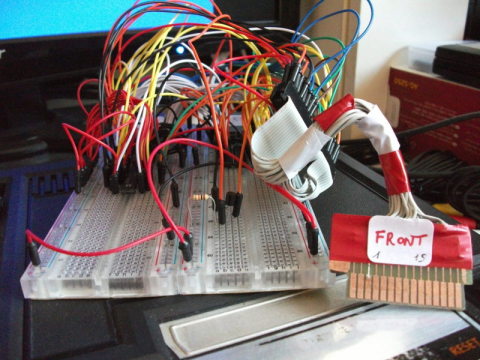
Enjoy,
Zx
To read more of the post and Download, click here!
 Join In and Discuss Here Join In and Discuss Here
Submit News and Releases Here and Contact Us for Reviews and Advertising Here |
|
 |
|
|
|
February 18th, 2013, 00:06 Posted By: wraggster
via http://www.atariage.com/
Tempest for the Atari 5200 is now available for purchase from the AtariAge Store!
For 15 years, the existence of an Atari 5200 version of Tempest was thought to be only myth. No prototypes had ever surfaced. A crude 2600 version had come to light, along with a prototype box. Then, in 1999, an unfinished working 5200 prototype appeared on eBay. The game was eventually dumped and the binary freely distributed around the Internet. Another decade has gone by since the game's discovery, and the original Atari 5200 Tempest programmer, Keithen Hayenga, worked to complete Tempest so it could finally see the light of day in completed form!
Tempest 5200 includes the game cartridge with glossy label, twelve page full-color, glossy manual, professionally offset printed box using chipboard paper stock, and cartridge insert to keep the cartridge in place. Only 250 boxed copies of Tempest will be produced! After that, the game will be sold without the box. If you want a boxed copy of the game, don't wait too long!
Order Tempest for the Atari 5200 Today!
To read more of the post and Download, click here!
 Join In and Discuss Here Join In and Discuss Here
Submit News and Releases Here and Contact Us for Reviews and Advertising Here |
|
 |
|
|
|
February 22nd, 2013, 01:01 Posted By: wraggster
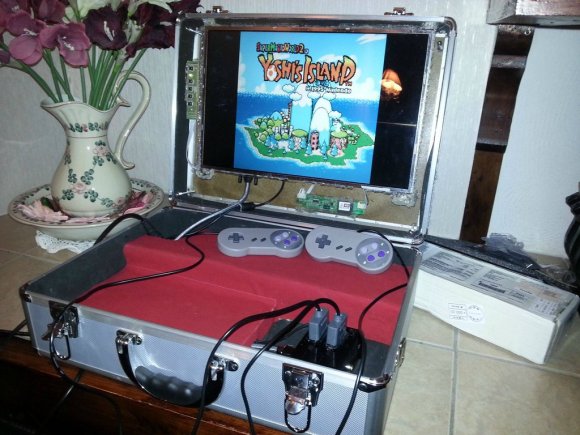
You can look and look, but you won’t find a Super Nintendo inside of this retro gaming rig. [Webrow] is giving his vintage hardware a rest, and taking this all-in-one game emulator suitcase wherever he goes.
The machine at the heart of his build is of course a Raspberry Pi. You really can’t beat the ubiquitous board for cost, power, and hardware extensibility. An LCD panel from a broken laptop comes along for the ride having been mounted in the lid. For a long time there was no hope for reusing these panels, but [Webrow] found an adapter board (for nearly the same price as the RPi) which converts the DVI from the Pi to the LVDS needed by the screen. The connections and mounting scheme for the screen were where most of the project work was done. Connecting the controllers simply involved soldering some SNES controller sockets to an RPi breakout connector. We do have to compliment him on the red bezel which hides all of the power cords and other unsightly bits. The case look sturdy and ready to play!
http://hackaday.com/2013/02/21/retro...-just-in-case/
To read more of the post and Download, click here!
 Join In and Discuss Here Join In and Discuss Here
Submit News and Releases Here and Contact Us for Reviews and Advertising Here |
|
 |
|
|
|
February 22nd, 2013, 01:16 Posted By: wraggster

You've blasted your way through the 20 games that come built into the Neo Geo X, so what's next? Last month, rumors the handheld had been discontinued suggested that was your lot, but the truth was less worrying: the limited edition Gold bundle run had come to an end. Now, Tommo Inc has detailed the first of five additional game cartridges for the portable. Neo Geo X Classics: Volume I will add 15 titles for you to wear your thumbs down on, including Metal Slug 2, King of Fighters '96and Fatal Fury: Mark of the Wolves. The cart is due to hit North America in April for an unspecified price, and those that pick one up will get a "Rocket" high-speed data transfer and charging cable gratis, as well as the Neo Geo X System Update 1.0, which we expect to hear more details on shortly. A travel case for the handheld is also in development, and is expected to be released the same month. Hit up the PR to see the full games list for Volume I, although chances are, some of you areplaying them already.
http://www.engadget.com/2013/02/21/n...ase-and-cable/
To read more of the post and Download, click here!
 Join In and Discuss Here Join In and Discuss Here
Submit News and Releases Here and Contact Us for Reviews and Advertising Here |
|
 |
|
|
|
February 22nd, 2013, 02:00 Posted By: wraggster
Handheld arcade platform NeoGeo X is adding 15 more retro games to its roster this April with NeoGeo X Classics: Volume 1, manufacturer Tommo has announced.NeoGeo X Classics: Volume 1 is the first of five anthologies that will contain umpteen games on one cart. This first volume includes: - Art of Fighting 3
- Blazing Star
- Breakers Revenge
- Fate Fury: Mark of the Wolves
- Kizuna Encounter
- The King of Fighters '96
- The Last Blade 2
- Metal Slug 2
- Samurai Showdown 3
- Savage Reign
- Sengoku
- Shock Troopers
- Super Sidekicks 3 - The Next Glory
- Top Hunter
- World Heroes Jet
http://www.eurogamer.net/articles/20...s-due-in-april
To read more of the post and Download, click here!
 Join In and Discuss Here Join In and Discuss Here
Submit News and Releases Here and Contact Us for Reviews and Advertising Here |
|
 |
|
|
|
February 23rd, 2013, 23:26 Posted By: wraggster
via http://www.romhacking.net/
Stand Guard is now version 4.0. Text has been overhauled from version 3.1 and many lines were edited. Look specifically in this version for the full libretto to Aria Di Mezzo Caraterre.
Additionally, the Sprint Shoes were changed to the Wingboots, which give stat boosts, and Tina starts with a Ward Bangle equipped, so there is an option for reduced encounters.
There’s an LP going on here.
http://www.romhacking.net/hacks/794/
To read more of the post and Download, click here!
 Join In and Discuss Here Join In and Discuss Here
Submit News and Releases Here and Contact Us for Reviews and Advertising Here |
|
 |
|
|
|
February 28th, 2013, 01:13 Posted By: wraggster
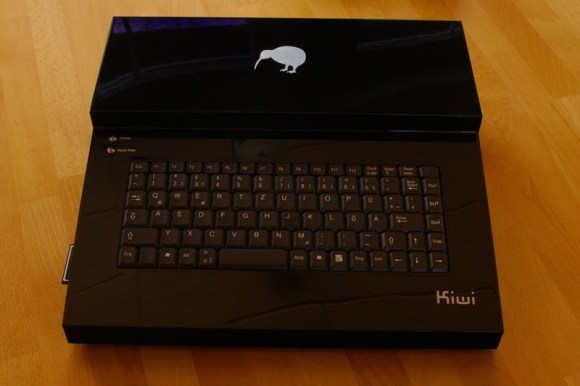
When you’re building one of the best homebrew computers ever created, you’ll also want a great case for it. This was [Simon]‘s task when he went about building an enclosure for his Kiwi microcomputer.
We were introduced to the Kiwi last year as the end result of [Simon] designing the ultimate computer from the early to mid-1980s. Inside is a 68008 CPU, similar to the processor found in early Macs and Amigas, two SID chips taken from a Commodore 64, Ethernet, support for IDE hard drives and floppy disks, and a video display processor capable of delivering VGA resolution video at 32-bit color depth. Basically, if this computer existed in 1982, it would either be hideously expensive or extraordinarily popular. Probably both, now that I think about it.
The case for the Kiwi was carefully cut from ABS sheets, glued together with acetone, and painted with auto body paint by a friend. It’s a great piece of work, but the effort may be for naught; [Simon] is reworking the design of his Kiwi computer, and hopefully he’ll be spinning a few extra boards for everyone else that wants a piece of the Kiwi.
http://hackaday.com/2013/02/27/the-c...-its-own-case/
To read more of the post and Download, click here!
 Join In and Discuss Here Join In and Discuss Here
Submit News and Releases Here and Contact Us for Reviews and Advertising Here |
|
 |
|
|
|
|
|











